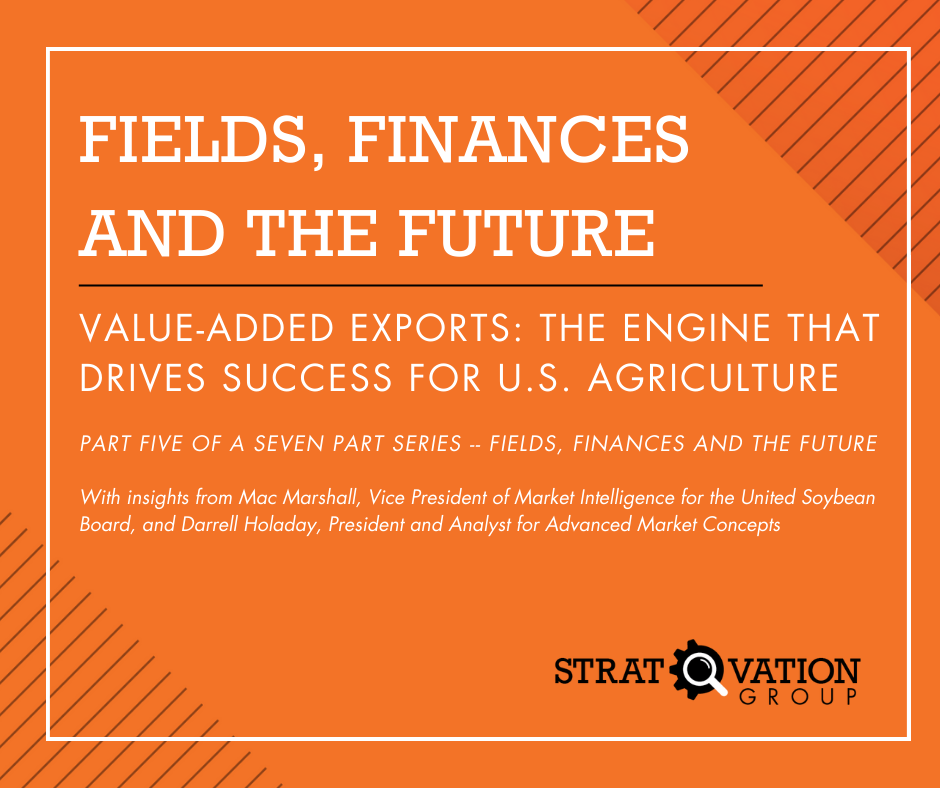Value-Added Exports: The Engine that Drives Success for U.S. Agriculture
Part five of a seven part series — Fields, Finances and the Future
Value-added. It’s a term that has been echoing through the food and agriculture value chain for decades. In stark terms, it means to add value in some way to a raw commodity and then marketing the resulting product at a higher price. While many examples of value-added strategies exist in the agricultural marketplace today, perhaps the easiest one to fathom is the conversion of U.S.-grown feed grains and oilseeds to livestock feed and then selling higher-valued meat rather than commoditized bulk crops.
While exporting bulk commodities remains vital to the overall profitability of America’s farmers, U.S. exports of corn and soybeans are facing a growing challenge in the global marketplace. In fact, Brazil is already the world’s largest exporter of soybeans, and analysts believe Brazil will surpass the United States in corn exports for the second time ever this year.
The competition from Brazil is also stiff in value-added categories, such as meat, but what Brazil does not have is the reputational advantage of U.S.-grown meat – beef, pork, poultry and lamb.
According to Darrell Holaday, President and Analyst for Advanced Market Concepts, to thrive in the global agricultural market, the United States needs to shift its focus.
“I’m not saying don’t export corn or soybeans,” he explained. “But the real advantage is to keep more of those commodities here at home as livestock feed. The quality of U.S.-grown meat in the consumers’ mind throughout the world is a big advantage.
“We can leverage that in producing high-quality meat products, such as beef, pork, and poultry, which are in high demand globally. By shifting toward value-added products American farmers can differentiate themselves from competitors and meet the increasing global demand for protein, which is on a continual track higher.”
Mac Marshall, Vice President of Market Intelligence for the United Soybean Board, also sees the direct connection between livestock feed and building value for commodities such as corn and soybeans. While expansions and contractions in the cattle cycle are more relevant for corn demand, soy is more important as feed for hogs and poultry. Domestically, nearly three quarters of all soybeans produced go into livestock feed.
“We definitely want to see continued growth in domestic livestock production, particularly in the swine area,” he said. I view that as an opportunity for increased soymeal inclusion as well as upsides for potential animal health and nutrition outcomes in swine.”
But he concedes, recently the U.S. meat industry has experienced additional consolidation, leading to the shuttering of some plants and breeding facilities. Another complicating factor is when demand for feed crops is decreased due to the outbreak of a livestock-related disease.
“Anytime there’s a large-scale outbreak of livestock disease, that does present significant potential for demand loss, like what we had with the highly pathogenic avian influenza outbreak,” Marshall said. “We saw that happen in other parts of the world as well, like what happened in China with ASF (African Swine Fever) and overall decreased demand.”
Whether looking at challenges or opportunities, the symbiotic relationship between crop and livestock producers results in a value-added export product, U.S.-grown meat, that consumers demand globally and with which other meat-exporting nations find it difficult to compete.
The agricultural economy can be a bumpy road, but through innovation, optimism and a spirit of resilience, America’s farmers are poised for the challenges and opportunities that lie ahead. Stratovation Group can help your company or organization strengthen your connection with farmers through research-informed strategies and consulting services. If interested in hearing more connect with Cam Camfield at cam@stratovationgroup.com.
Next Up Part Six: Innovation Continues to Blaze a Trail for Profit and Sustainability

